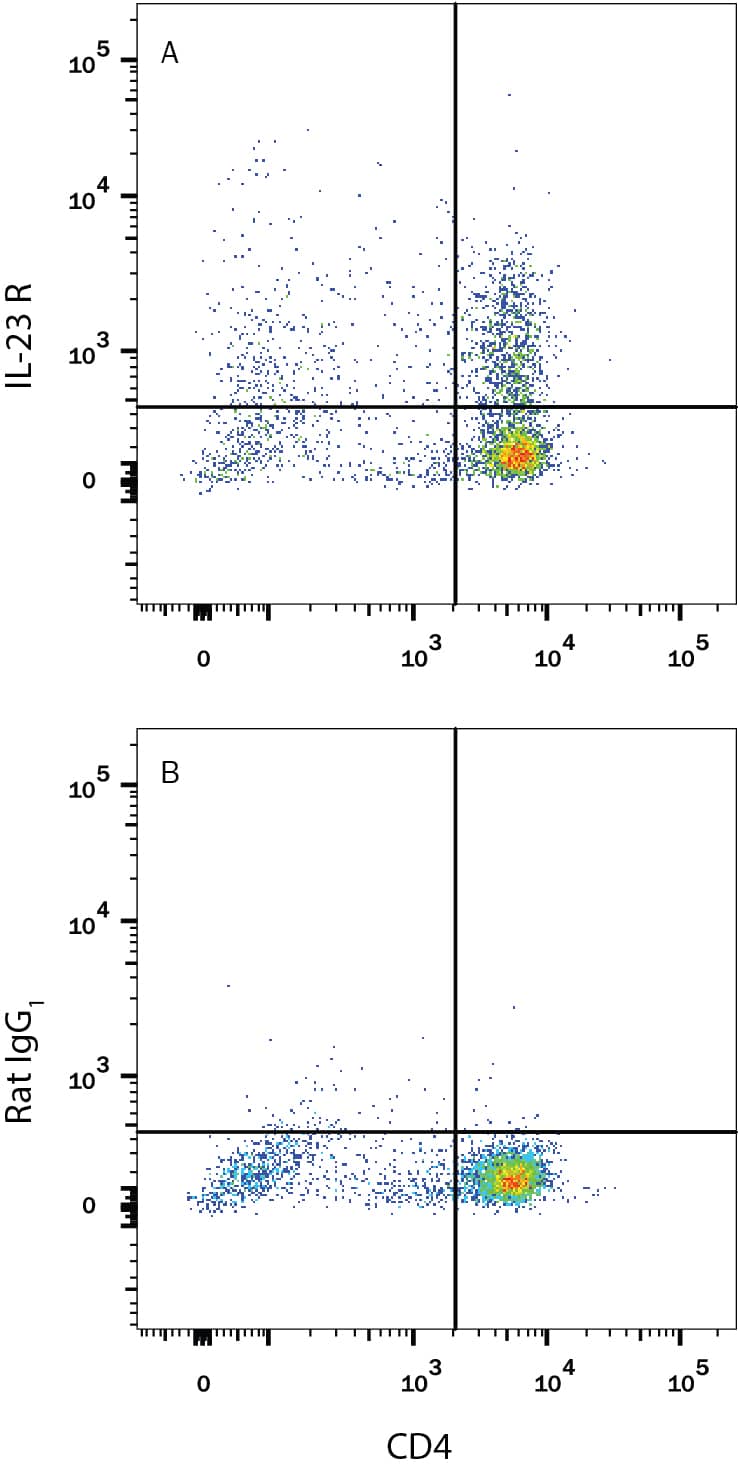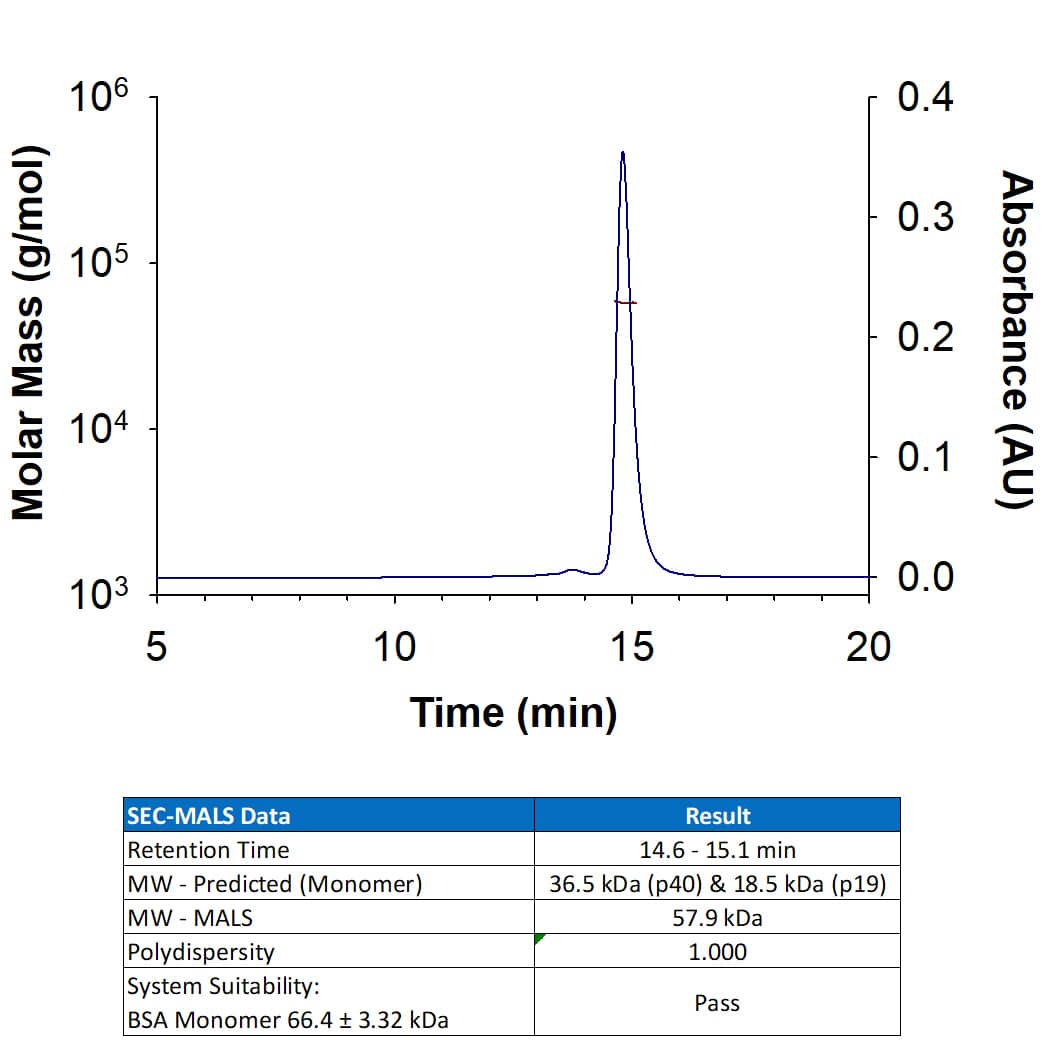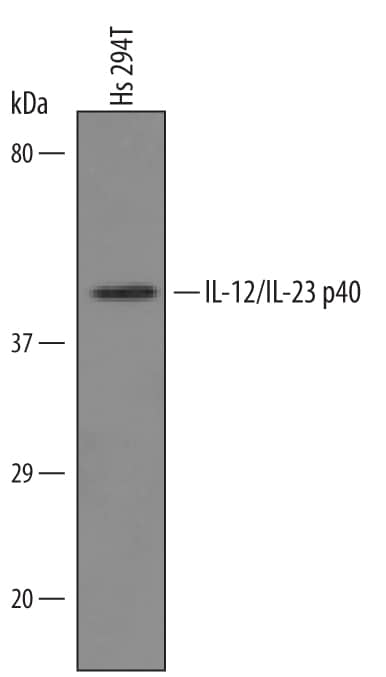Mouse IL-23R Antibody Summary
Gly24-Asp372
Accession # Q8K4B4
Customers also Viewed
Applications
Please Note: Optimal dilutions should be determined by each laboratory for each application. General Protocols are available in the Technical Information section on our website.
Scientific Data
 View Larger
View Larger
IL‑17 Secretion Induced by IL‑23 and Neutralization by Mouse IL‑23 R Antibody. In the presence of Recombinant Mouse IL‑2 (10 ng/mL, Catalog # 402-ML), Recombinant Mouse IL‑23 (Catalog # 1887-ML) stimulates IL‑17 secretion in mouse splenocytes in a dose-dependent manner (orange line), as measured by the Mouse IL‑17 Quantikine ELISA Kit (Catalog # M1700). Under these conditions, IL‑17 secretion elicited by Recombinant Mouse IL‑23 (0.75 ng/mL) is neutralized (green line) by increasing concentrations of Mouse IL‑23 R Monoclonal Antibody (Catalog # MAB1686). The ND50 is typically 0.1-0.4 µg/mL.
Preparation and Storage
- 12 months from date of receipt, -20 to -70 °C as supplied.
- 1 month, 2 to 8 °C under sterile conditions after reconstitution.
- 6 months, -20 to -70 °C under sterile conditions after reconstitution.
Background: IL-23R
Interleukin 23 (IL-23) is a heterodimeric cytokine composed of two disulfide-linked subunits, a p19 subunit that is unique to IL-23, and a p40 subunit that is shared with IL-12 (1‑5). The functional IL-23 receptor complex consists of two receptor subunits, the IL-12 receptor beta 1 subunit (IL-12 R beta 1) and the IL-23-specific receptor subunit (IL-23 R) (3). Mouse IL-23 R cDNA encodes a 644 amino acid (aa) type I transmembrane protein with a 23 aa residue signal peptide, a 349 aa residue extracellular domain, a 23 aa residue transmembrane domain and a 249 aa residue cytoplasmic region. IL-23 R shares structural features with the IL-12 R beta 2, including an N-terminal Ig-like domain, two cytokine receptor domains and multiple glycosylation sites in the extracellular domain. IL-23 R lacks the three extracellular membrane-proximal fibronectin-type III domains present on IL-12 R beta 2. IL-23 R has a WQPWS sequence in the transmembrane-proximal cytokine receptor domain similar to the cytokine receptor signature WSXWS motif. The cytoplasmic region of IL-23 R has three potential Src homology 2 domain-binding sites and two potential Stat-binding sites. The gene for human IL-23 R is located on human chromosome 1 within 150 kb of IL-12 R beta 2. Human and mouse IL-23 R share 66% amino acid sequence identity. Mouse IL-23 R is expressed in mouse Th1 and Th2 cells, bone marrow, dendritic cells and macrophages. It is also expressed by mouse CD4+ CD45RBlow memory T cells but at much lower levels by mouse CD4+ CD45RBhigh cells. IL-23 initiates a signal transduction cascade similar to that of IL-12 and involves Jak2, Tyk2, STAT1, STAT3, STAT4, and STAT5. IL-23 has biological activities that are similar to, but distinct from, IL-12.
- Oppmann, B. et al. (2000) Immunity 13:715.
- Lankford, C.S. and D.M. Frucht (2003) J. Leukoc. Biol. 73:49.
- Parham, C. et al. (2002) J. Immunol. 168:5448.
- Belladonna, M.L. et al. (2002) J. Immunol. 168:5448.
- Aggarwal, S. et al. (2003) J. Biol. Chem. 278:1910.
Product Datasheets
Citations for Mouse IL-23R Antibody
R&D Systems personnel manually curate a database that contains references using R&D Systems products. The data collected includes not only links to publications in PubMed, but also provides information about sample types, species, and experimental conditions.
12
Citations: Showing 1 - 10
Filter your results:
Filter by:
-
Synthetic deletion of the Interleukin 23 receptor (IL-23R) stalk region led to autonomous IL-23R homodimerization and activation
Authors: TM Hummel, T Ackfeld, M Schönberg, G Ciupka, F Schulz, A Oberdoerst, J Grötzinger, J Scheller, DM Floss
Mol. Cell. Biol., 2017-08-11;0(0):.
-
Distinctive CD39+CD9+ lung interstitial macrophages suppress IL-23/Th17-mediated neutrophilic asthma by inhibiting NETosis
Authors: Han, S;Kim, B;Hyeon, DY;Jeong, D;Ryu, J;Nam, JS;Choi, YH;Kim, BR;Park, SC;Chung, YW;Shin, SJ;Lee, JY;Kim, JK;Park, J;Lee, SW;Kim, TB;Cheon, JH;Cho, HJ;Kim, CH;Yoon, JH;Hwang, D;Ryu, JH;
Nature communications
Species: Mouse
Sample Types: Whole Cells
Applications: Bioassay -
The functions of IL-23 and IL-2 on driving autoimmune effector T-helper 17 cells into the memory pool in dry eye disease
Authors: Y Chen, C Shao, NW Fan, T Nakao, A Amouzegar, SK Chauhan, R Dana
Mucosal Immunol, 2020-04-23;0(0):.
Species: Mouse
Sample Types: Tissue
Applications: in vivo blocking -
Integration of T Cell Receptor, Notch and Cytokine Signals Programs in Mouse ?? T Cell Effector Differentiation
Authors: P Zarin, TSH In, ELY Chen, J Singh, GW Wong, M Mohtashami, DL Wiest, MK Anderson, JC Zúñiga-Pfl
Immunol. Cell Biol., 2018-06-28;0(0):.
Species: Mouse
Sample Types: Complex Sample Type
Applications: Neutralization -
IL-23 Inhibits Melanoma Development by Augmenting DNA Repair and Modulating T Cell Subpopulations
Authors: Tahseen H Nasti
J. Immunol, 2016-12-21;0(0):.
Species: Mouse
Sample Types: Whole Cells
Applications: Flow Cytometry -
Staphylococcus aureus infection of mice expands a population of memory gammadelta T cells that are protective against subsequent infection.
Authors: Murphy A, O'Keeffe K, Lalor S, Maher B, Mills K, McLoughlin R
J Immunol, 2014-03-12;192(8):3697-708.
Species: Mouse
Sample Types: Whole Cells
Applications: Neutralization -
Pathological Role of Interleukin-17 in Poly I:C-Induced Hepatitis
Authors: Jianqin He, Guanjing Lang, Shiping Ding, Lanjuan Li
PLoS ONE
-
IL-22 from conventional NK cells is epithelial regenerative and inflammation protective during influenza infection.
Authors: Kumar P, Thakar M, Ouyang W, Malarkannan S
Mucosal Immunol, 2012-06-27;6(1):69-82.
Species: Mouse
Sample Types: Whole Cells
Applications: Flow Cytometry -
Contribution of IL-17-producing gamma delta T cells to the efficacy of anticancer chemotherapy.
Authors: Ma Y, Aymeric L, Locher C, Mattarollo SR, Delahaye NF, Pereira P, Boucontet L, Apetoh L, Ghiringhelli F, Casares N, Lasarte JJ, Matsuzaki G, Ikuta K, Ryffel B, Benlagha K, Tesniere A, Ibrahim N, Dechanet-Merville J, Chaput N, Smyth MJ, Kroemer G, Zitvogel L
J. Exp. Med., 2011-03-07;208(3):491-503.
Species: Mouse
Sample Types: Whole Cells
Applications: Neutralization -
A human colonic commensal promotes colon tumorigenesis via activation of T helper type 17 T cell responses.
Authors: Wu S, Rhee KJ, Albesiano E, Rabizadeh S, Wu X, Yen HR, Huso DL, Brancati FL, Wick E, McAllister F, Housseau F, Pardoll DM, Sears CL
Nat. Med., 2009-08-23;15(9):1016-22.
Species: Mouse
Sample Types: In Vivo
Applications: Neutralization -
Cutting edge: An in vivo requirement for STAT3 signaling in TH17 development and TH17-dependent autoimmunity.
Authors: Harris TJ, Grosso JF, Yen HR, Xin H, Kortylewski M, Albesiano E, Hipkiss EL, Getnet D, Goldberg MV, Maris CH, Housseau F, Yu H, Pardoll DM, Drake CG
J. Immunol., 2007-10-01;179(7):4313-7.
Species: Mouse
Sample Types: In Vivo
Applications: Neutralization -
Resident Vdelta1+ gammadelta T cells control early infiltration of neutrophils after Escherichia coli infection via IL-17 production.
Authors: Shibata K, Yamada H, Hara H, Kishihara K, Yoshikai Y
J. Immunol., 2007-04-01;178(7):4466-72.
Species: Mouse
Sample Types: Whole Cells
Applications: Neutralization
FAQs
No product specific FAQs exist for this product, however you may
View all Antibody FAQsIsotype Controls
Reconstitution Buffers
Secondary Antibodies
Reviews for Mouse IL-23R Antibody
There are currently no reviews for this product. Be the first to review Mouse IL-23R Antibody and earn rewards!
Have you used Mouse IL-23R Antibody?
Submit a review and receive an Amazon gift card.
$25/€18/£15/$25CAN/¥75 Yuan/¥2500 Yen for a review with an image
$10/€7/£6/$10 CAD/¥70 Yuan/¥1110 Yen for a review without an image


















